How to configure java environment variables
Jan 13, 2020 pm 04:07 PMHow to configure java environment variables: 1. Right-click [Computer], select [Properties], click [Advanced System Settings] to open the environment variable settings; 2. Create a new [JAVA_HOME] variable and edit [Path] ] variable; 3. Create a new [Classpath] variable and edit it.
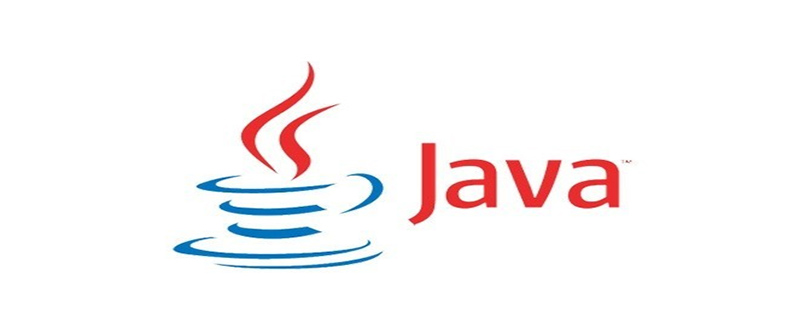
Specific method:
JAVA_HOME variable setting
First right-click [Computer] to enter [ Properties] and then select [Advanced system settings].
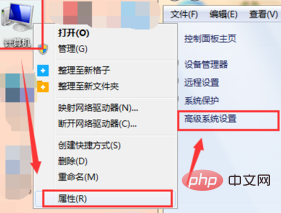
Click [Environment Variables] in [Advanced] to enter the environment variable editing interface.
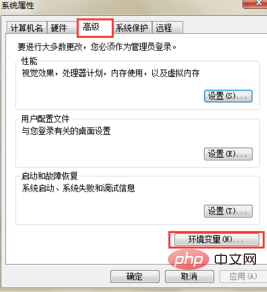
In the [System Variables] below, the JAVA_HOME variable does not exist, then we need to click [New]
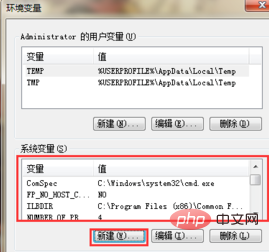
Variable name input: JAVA_HOME
(Free video tutorial sharing: java video tutorial)
The variable value refers to the actual installation path (such as the editor’s path is: C:\Program Files\Java\jdk-9), and finally click OK.
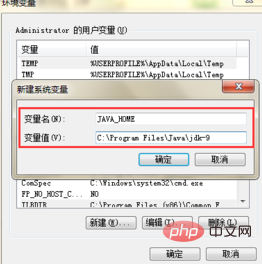
Path variable setting
Also in [System Variables] we can see that the path variable already exists, then we only You need to click [Edit] to enter the editing of the path variable
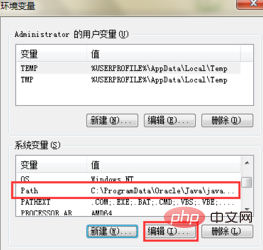
The variable name remains unchanged and the variable value is changed to [%JAVA_HOME%\bin;%JAVA_HOME%\jre\bin; ], and finally click OK.
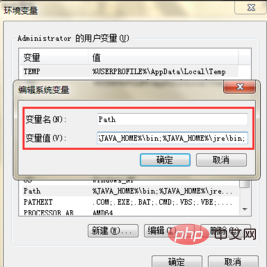
Classpath variable setting
Similarly, there is no Classpath variable in the system variables. Click to enter [New]
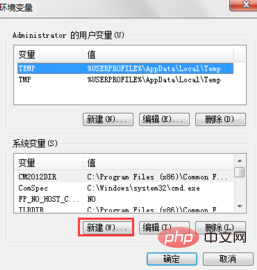
Type the variable name [Classpath]
Type the variable value [.;%JAVA_HOME%\lib\dt.jar;%JAVA_HOME %\lib\tools.jar; ]
Note: Do not miss the symbols in the variable value, and finally click OK.

Test whether the environment configuration is successful
After completing the above three variable configurations, don’t forget to click OK step by step.
Similarly, search [cmd] in [Start], then type [java] and [javac], and the message as shown in the figure will appear, indicating that the configuration is successful.
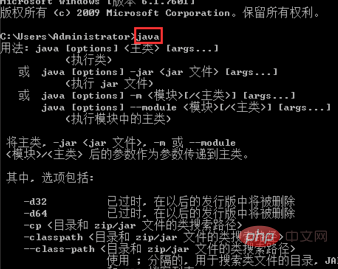
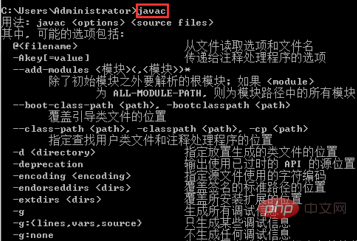
Recommended related articles and tutorials: java introductory tutorial
The above is the detailed content of How to configure java environment variables. For more information, please follow other related articles on the PHP Chinese website!

Hot AI Tools

Undress AI Tool
Undress images for free

Undresser.AI Undress
AI-powered app for creating realistic nude photos

AI Clothes Remover
Online AI tool for removing clothes from photos.

Clothoff.io
AI clothes remover

Video Face Swap
Swap faces in any video effortlessly with our completely free AI face swap tool!

Hot Article

Hot Tools

Notepad++7.3.1
Easy-to-use and free code editor

SublimeText3 Chinese version
Chinese version, very easy to use

Zend Studio 13.0.1
Powerful PHP integrated development environment

Dreamweaver CS6
Visual web development tools

SublimeText3 Mac version
God-level code editing software (SublimeText3)

Hot Topics
 Selecting Specific Columns | Performance Optimization
Jun 27, 2025 pm 05:46 PM
Selecting Specific Columns | Performance Optimization
Jun 27, 2025 pm 05:46 PM
Selectingonlyneededcolumnsimprovesperformancebyreducingresourceusage.1.Fetchingallcolumnsincreasesmemory,network,andprocessingoverhead.2.Unnecessarydataretrievalpreventseffectiveindexuse,raisesdiskI/O,andslowsqueryexecution.3.Tooptimize,identifyrequi
 What is the `enum` type in Java?
Jul 02, 2025 am 01:31 AM
What is the `enum` type in Java?
Jul 02, 2025 am 01:31 AM
Enums in Java are special classes that represent fixed number of constant values. 1. Use the enum keyword definition; 2. Each enum value is a public static final instance of the enum type; 3. It can include fields, constructors and methods to add behavior to each constant; 4. It can be used in switch statements, supports direct comparison, and provides built-in methods such as name(), ordinal(), values() and valueOf(); 5. Enumeration can improve the type safety, readability and flexibility of the code, and is suitable for limited collection scenarios such as status codes, colors or week.
 Applying Semantic Structure with article, section, and aside in HTML
Jul 05, 2025 am 02:03 AM
Applying Semantic Structure with article, section, and aside in HTML
Jul 05, 2025 am 02:03 AM
The rational use of semantic tags in HTML can improve page structure clarity, accessibility and SEO effects. 1. Used for independent content blocks, such as blog posts or comments, it must be self-contained; 2. Used for classification related content, usually including titles, and is suitable for different modules of the page; 3. Used for auxiliary information related to the main content but not core, such as sidebar recommendations or author profiles. In actual development, labels should be combined and other, avoid excessive nesting, keep the structure simple, and verify the rationality of the structure through developer tools.
 VSCode debugger for Java setup guide
Jul 01, 2025 am 12:22 AM
VSCode debugger for Java setup guide
Jul 01, 2025 am 12:22 AM
The key steps in configuring the Java debugging environment on VSCode include: 1. Install JDK and verify; 2. Install JavaExtensionPack and DebuggerforJava plug-in; 3. Create and configure the launch.json file, specify mainClass and projectName; 4. Set up the correct project structure to ensure the source code path and compilation output are correct; 5. Use debugging techniques such as Watch, F8/F10/F11 shortcut keys and methods to deal with common problems such as class not found or JVM attachment failure.
 How do I get environment variables using the os.Getenv() function in Go?
Jun 27, 2025 am 02:04 AM
How do I get environment variables using the os.Getenv() function in Go?
Jun 27, 2025 am 02:04 AM
TogetenvironmentvariablesinGo,useos.Getenv(),butconsiderLookupEnvforexistencechecks.1.Useos.Getenv("VAR_NAME")toretrieveavariable’svalueasastring,returningemptyifunset.2.Useos.LookupEnv()todistinguishbetweenunsetandemptyvariables.3.Provided
 How do I set up VS Code for Java development?
Jun 29, 2025 am 12:23 AM
How do I set up VS Code for Java development?
Jun 29, 2025 am 12:23 AM
To use VSCode for Java development, you need to install the necessary extensions, configure the JDK and set up the workspace. 1. Install JavaExtensionPack, including language support, debugging integration, build tools and code completion functions; optional JavaTestRunner or SpringBoot extension package. 2. Install at least JDK17 and verify through java-version and javac-version; set the JAVA_HOME environment variable, or switch multiple JDKs in the status bar at the bottom of VSCode. 3. After opening the project folder, make sure the project structure is correct and enable automatic saving, adjust the formatting rules, enable code checking, and configure the compilation task to optimize the opening.
 Windows search bar not typing
Jul 02, 2025 am 10:55 AM
Windows search bar not typing
Jul 02, 2025 am 10:55 AM
When the Windows search bar cannot enter text, common solutions are: 1. Restart the Explorer or computer, open the Task Manager to restart the "Windows Explorer" process, or restart the device directly; 2. Switch or uninstall the input method, try to use the English input method or Microsoft's own input method to eliminate third-party input method conflicts; 3. Run the system file check tool, execute the sfc/scannow command in the command prompt to repair the system files; 4. Reset or rebuild the search index, and rebuild it through the "Index Options" in the "Control Panel". Usually, we start with simple steps first, and most problems can be solved step by step.
 Using Config Helper | Accessing Configuration Values
Jun 27, 2025 pm 05:45 PM
Using Config Helper | Accessing Configuration Values
Jun 27, 2025 pm 05:45 PM
ConfigHelper is a helper class or function that encapsulates configuration read logic for extracting values ??from configuration files and improving code maintainability. 1. It avoids hard coding through centralized management of configurations; 2. It can be implemented as an extended structure that supports multi-level, cache, encryption and other functions; 3. Common configuration storage methods include .env files, JSON/YAML files, databases and environment variables; 4. When using it, the configuration files should be split reasonably, the default values ??should be provided, sensitive information should be distinguished, and the caching mechanism should be paid attention to.






